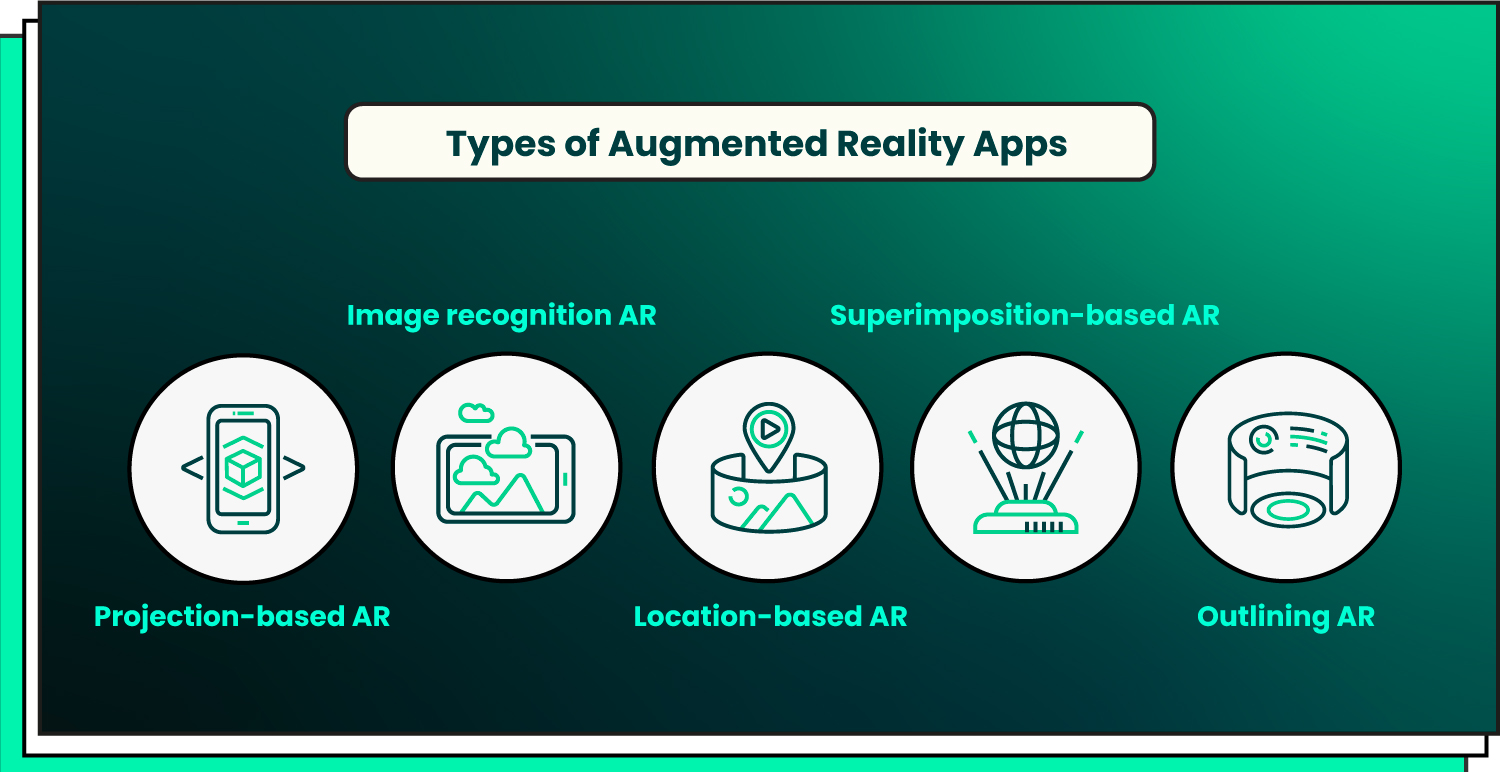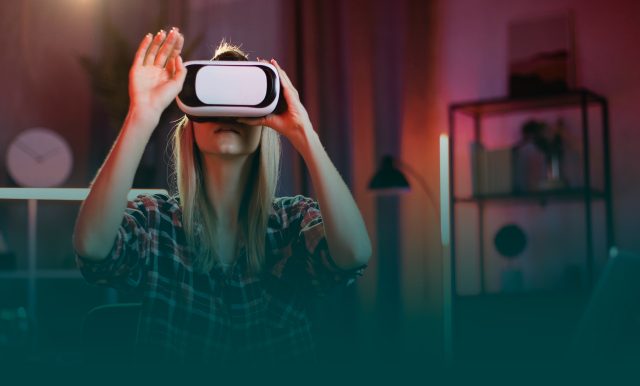Will Augmented Reality app development become a new explosive market niche like blockchain, 3D printing, or neural networks? While the IT sector is on a quest for new powerful growth points, Augmented Reality (AR) remains massively underexplored. This identifies that it keeps the tremendous success prospect for tech business people choosing it. In this article, we’ll discuss AR technology’s future, benefits, and project ideas. Also, we’ll offer an Augmented Reality app creation algorithm for all potential AR business start-ups.
Here is a small pinch of optimistic marketing figures: the global Augmented Reality (AR) market size is going to exceed $460 Billion by 2030, which means growing at a CAGR of nearly 40%. That’s why investing in developing augmented reality apps today can bring significant business outcomes tomorrow.
AR technology refers to a specific spectrum of digital transformation methods that combines the contexts of the digital and real worlds. This approach includes two major components:
- Real-life video, audio, or photo obtained via digital cameras, and more optional data from different sensors: GPS location, device position, optical parameters, kinetic data, and so on.
- Virtual objects overlaying and enriching video or photo in real-time: superimposed text messages, hints, images, sub-videos, modification, and animated 3D models.
The second point of this formula describes the process of reality augmentation — virtual entities add helpful information and extend knowledge in the context of real objects and settings. You can experience AR through various devices such as smartphones, tablets, smart glasses, and head-mounted displays. If you require immediate help with AR app development, please contact our team for AR engineering consulting and other IT services.
Augmented Reality in Business: 5 AR Startup Ideas
To develop Augmented Reality apps enabling powerful market growth, you need to pick among myriad promising AR opportunities and ideas to go with. Even though the majority of AR development startups and initiatives belong to the following industries, there are still lots of “blank spots” to eliminate:
- Education & training
- Technical instructing
- Professional guidance
- 3D Entertainment
- Warehousing
- Navigation
- Analytics
- Shopping
- Real estate
- 3D Design
- Gaming
Augmented Reality Tech for Better House Management
This can include a variety of interactive educational materials on domestic skills, DIY topics, instructions for home appliance repair, interior design tips, and more, so users can learn while doing usual things at home. For example, why don’t you master some helpful plant cultivation techniques while you’re actually gardening? An AR device can follow and support you everywhere providing practical advice.
AR Application Rendering Cooking Tips & Recipes
Let’s say you open your fridge in the morning and find a couple of eggs, some milk, and assorted vegetables there. Thanks to your smart AR glasses or any other AR-compatible device you use, your Augmented Reality app indicates these products and estimates their amounts. In a matter of moments, the AR solution automatically connects the dots and suggests several healthy dishes you can cook out of these products. In addition, it provides you with instructions to accomplish the recipe. That’s what we call a smart breakfast!
Assistance in Learning Languages with AR Apps
Each real-life phenomenon or object you observe through your VR device can be instantly identified and overlaid by its name in a foreign language. This includes an option to listen to each word’s native pronunciation with sentence examples. AR enables a truly learn-as-you-go approach, leveling up your language experience in terms of fun and gamification practices. For example, Google released an AR translator they mentioned as “subtitles to the world”. This tool converts human speech to a written translation seen via smart glasses — why don’t you give a try to linguistic AR project?
Augmented Reality Apps for Professional Training
AR technologies can be introduced to educational processes and training programs for different professionals, like:
- Emergency responders
- Medical employees
- Rescuers
- Military personnel
- Firefighters
This refers to placing students, interns, and cadets into virtually augmented environments where dangerous situations are facilitated via AR-provided action plans, instructions, and professional narratives, reducing stress and improving learning outcomes.
Historical Reenactments & Reconstruction with AR
Visiting historical sites can be a pretty exciting experience until you bump into the boring side of history: long tourist handbooks and traditional narratives full of dry facts, dates, and numbers irrelevant to modern life. AR has the potential to change this forever.
Imagine that instead of an ancient castle ruined centuries ago, you can observe a precise AR reconstruction of its appearance in the heyday of its glory. This reenactment scenery can include walkable virtual interiors and courtyards populated with people in historical clothes strolling around.
For example, there exists a Berlin Wall’s history AR app that brings images of the past back to life — yet the number of historical sites that can be potentially animated with AR is unlimited!
The Benefits of Augmented Reality for Businesses
What makes Augmented Reality so effective? Here are three psychological explanations embraced by all successful Augmented Reality app developers and used to nurture market success for their applications:
- Contextualization: AR lets new experiences and knowledge come about situations and environments, which makes them easier to cognize.
- Emotional reaction: The use of AR provokes an emotional response in users, which stimulates mental processes, increases attention, and positively affects the learning process overall.
- Memory retention: Thanks to emotional triggers, contexts, and hands-on experience, the user’s brain better retains the new skills and knowledge acquired via AR practices.
There exist numerous reasons for IT entrepreneurs to create an Augmented Reality app. The advantages granted by AR solutions include:
AR Tech Brings Innovative Shopping Experiences
AR ensures extremely helpful shopping services that help customers visualize how different interior products will look in their homes before purchasing. For example, IKEA’s AR app encourages customers to select furniture by previewing it within their house or apartment settings. To reproduce this strategy for your business, an AR application must feature digitized 3D replicas of different products offered in your product catalog.
There exist different software packages enabling 3D photography and virtualization of furniture, decorations, and other objects. Alternatively, there even exist tools that can help you turn 2D images into 3D objects for AR app integrations and asset modeling.
AR Fuels Customer Engagement
AR-powered marketing tricks, like the one described above, can create immersive experiences that capture customers’ attention, keep them engaged with the brand and its products, and encourage people to come for more exciting interactions and discoveries.
This is an original gamification method introduced by AR. It organically leverages people’s curiosity to foster customer satisfaction, engagement, loyalty, and sales, without pushy marketing practices.
AR Introduces Cost-Effective Prototyping and Design
AR can help industrial and interior designers save a great deal of time and money by skipping the physical modeling phase. Thanks to digital prototyping and AR capabilities, it’s possible to integrate simulated objects into physical environments to test them. This approach helps minimize the costs of crafting tangible samples. AR-compatible 3D models can be created via graphic design software broadly represented on the market.
AR for Increased Efficiency in Training and Operations
AR is a game-changing tech when it comes to training employees. It helps people master new complex procedures and equipment in less time and reduces the need for costly on-site training. Once employees are already deployed to their positions and workplaces, AR improves their efficiency in operations, thanks to ongoing VR-supported reminders, guidance, and instructions.
Augmented Reality Adds a Competitive Edge
By adopting AR technology apps, businesses can differentiate themselves from competitors and offer unique experiences that set their products and services apart in the market. If you decide to develop an augmented reality app, it’s a strong signal for your clients and investors, demonstrating that you keep pace with top-notch technologies.
6 Steps for Building an Augmented Reality App
How to outperform your competitors? The paramount priority of an Augmented Reality app developer is to create an efficient AR software logic engine capable of these functions:
- Visual detection and recognition of objects in the real world;
- Intelligent association and coordination of these objects with virtual concepts in software databases.
The more streamlined the performance of the AR software engine, the smoother the AR experience rendered to the users is, and the higher your chances for success. Building an Augmented Reality app can seem a daunting task, taking plenty of time and tech skills. We want to facilitate this process for you with this AR apps development algorithm:
Step #1. Define Your AR App’s Purpose and Market Conception
Make sure to complete all preparations:
- Describe your customer personas
- Write AR app usability scenarios
- Identify your app’s USPs
- Define your WOW-effect points.
With these points completed, you can easily design the AR application UI/UX, plan the app’s features, and then craft all virtual content to fulfill your target audience’s expectations and requirements. Below, you can see a general type of AR applications:

- Projection-based AR app modifies an object with respect to the physical features and parameters of an environment.
- Image recognition AR app recognizes a visual pattern or tracks a specific marker, such as a QR code.
- A location-based AR app takes into account your current location and suggests navigational tools and services, like virtual arrows leading you to your target.
- Superimposition-based AR app overlies real objects with helpful models and simulations. For example, a doctor can learn about the pain points of a specific patient through virtual images or markers superimposed on their body right during an office appointment or procedure.
- Outlining AR apps recognize boundaries and lines when the human eye fails to see the whole picture. This is mainly used for operating vehicles, like parking a car in a poorly demarcated parking lot.
Step #2. Gather a Potent Team of AR Specialists
It’s impossible to create augmented reality apps until you have skilled AR development engineers in place. Standard team composition can include:
- Project managers
- Software architects
- UI and 3D designers
- App testers and QA managers
- Application developers who are masterful in augmented reality programming techniques, such as marker tracking and markerless tracking.
You can hire the required AR specialists in a variety of ways: traditional employment scenarios, short-time contractors, or hire a custom application development dedicated team.
Step #3. Choose an AR Development Platform
- Identify devices that you want to create an Augmented Reality app for: will those gadgets be usual iOS or Android smartphones, a web-based solution, or some sort of a specialized device like HoloLens from MS?
- Based on your previous choice, you can select from several AR software development kits available out there, including ARKit (for iOS), ARCore (for Android), Vuforia (for Windows), and several others.
- To choose a toolkit that is the best fit for your platform and app features, you need to involve a skilled AR development specialist, or you may consult with one of our AR and mobile software engineers.
Step #4. Create 3D Models and AR App Assets
To provide your users with a pleasant and smooth AR experience, you have to build high-quality 3D models and other Augmented Reality assets that can be rendered in the real world.
- Create 3D and 2D content for the inbuilt app library. There are many professional graphic design suites available for creating splendid 3D models, including Blender, Maya, and SketchUp.
- Involve skilled 3D designers and, probably, digital illustration artists if you want to create AR games and other apps with a significant entertainment component.
- If your AR application idea includes digitizing real objects (like tangible products and furniture), set up the AR scene with a camera view, lighting, and object positioning. Make sure the project digitizing algorithm will be built into your app.
- Define the anchor points* and create reference images** that will trigger the AR experience (depending on the method you choose for your application).
*Anchor points: Fixed locations or easily recognizable items that must trigger the AR functionality once detected. This might be something typical and algorithmically described, like a horizon, piece of furniture, wall, or window.
**Reference images: Specially designed images with clear, contrasting, and distinguishable details, such as QR codes, product packaging, logos, or posters, which must activate AR functionality in applications.
Step #5. Integrate AR Features into the App
Once you have created your 3D models and AR assets, you need to integrate them into the AR development platform and build AR features such as object recognition, image tracking, machine learning capabilities for AR, and location-based AR:
- Choose a programming language that is compatible with the AR platform, such as Swift or Objective-C for iOS, React JavaScript for Android, or C++ for the .NET platform.
- Configure your development environment. Install the necessary software, such as Android Studio for Android development or .NET development suite for mobile.
- Build your AR application engine and UI interface. Code the application logic to manage the AR experience and algorithms including detecting user actions, device calibration, rendering animating objects, and/or displaying information.
- Test your AR application on all device configurations, manage the QA process, and make sure the acceptance testing is completely passed.
Step #6. Publish and Maintain the AR App
- Configure and deploy the server component of your Augmented Reality application. This task requires DevOps expertise and skills.
- Publish your AR product in application directories. Prepare the necessary documentation, including the user privacy agreement. Once the app is tested and ready, you can publish it to the app store or distribute it through other channels.
- Update and maintain the app continuously: AR technology is constantly evolving, so it’s important to keep up with the progress and ensure the product remains compatible with new devices/platforms and continues to provide a high-quality AR experience.

AR Development Challenges and Solutions
Limited AR device compatibility. Since AR technologies are relatively new, it can be difficult to predict if certain Augmented Reality applications are set to work smoothly and correctly with different devices. To overcome this issue, developers should choose a widely compatible platform and optimize the app for a variety of popular devices and/or operating systems. This requires increased application testing, tech performance assessment, and QA efforts.
Complicated AR object tracking and calibration. AR apps require accurate tracking and calibration to ensure that the digital objects are aligned correctly with the real-world environment and features. To address this concern, developers can use computer vision and machine learning techniques to improve tracking accuracy and reduce calibration time and errors.
AR applications can be hard for users to interact with. Because of many Augmented Reality specifics, AR apps require advanced user readiness, including sufficient manual skills in interacting with touch screens and other tech skills. To facilitate user experience, developers can implement additional forms of intuitive user interfaces, like voice command and gesture recognition. This can help reduce manual operation and help users adapt to Augmented Reality faster.
Future of Augmented Reality: The Three Major Trends
The future of Augmented Reality (AR) is very bright, with the technology poised to revolutionize the way we interact with the technology and the world around us. The upcoming wave of potential developments and novelty applications is huge, but you have time to catch up with AR opportunities. The expected AR trends include:
Increased adoption in industries and everyday life. AR technology will be incrementally implemented across all industries and massively represented in healthcare, education, entertainment, retail, and manufacturing. For certain industries, Augmented Reality can even become a mainstream tech.
More advanced AR hardware and tools enter the scene. As the potential of AR technology continues to unveil, new advanced AR gadgets are going to be designed and released. This represents a very wide spectrum of opportunities for devices like smart glasses, contact lenses, digital helmets, or even smart implants.
Integration with other technologies. We’ll see many interesting technological combinations, like AR plus artificial intelligence, and/or the Internet of Things. Those systems will help developers create even more powerful and immersive experiences. AR will be used to manage user-centric IoT environments involving handheld devices, smart home appliances, and professional workstations. Another hybrid tech to emerge is a blend between AR and virtual reality (VR) providing seamless transitions between virtual and real-world environments.
Final Word
With the trends explained above, the AR industry has tremendous potential to grow and cover new industries. It is expected that this business will exceed $130 billion in revenue by 2028. If you want to become a part of the augmented reality future, it’s the right time to develop your own AR application project.
Forbytes team is ready to help you with AR application engineering, design, development, and testing. Contact us today for more information.

Our Engineers
Can Help
Are you ready to discover all benefits of running a business in the digital era?

Our Engineers
Can Help
Are you ready to discover all benefits of running a business in the digital era?








